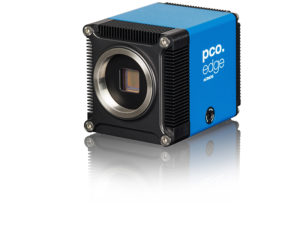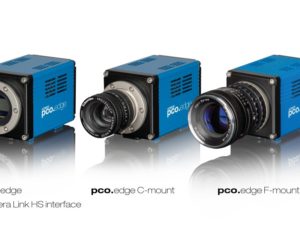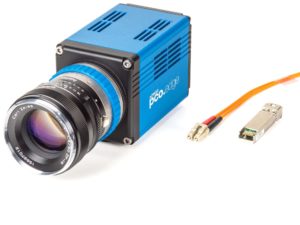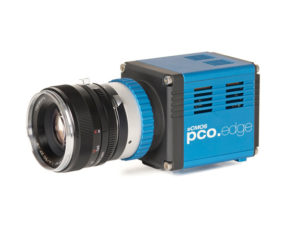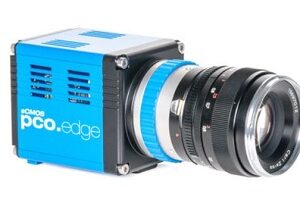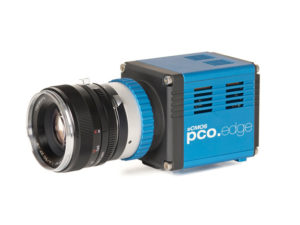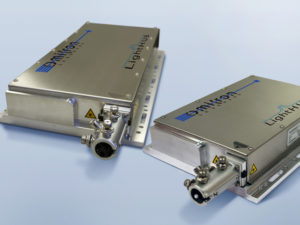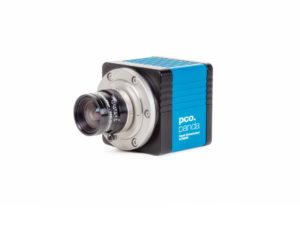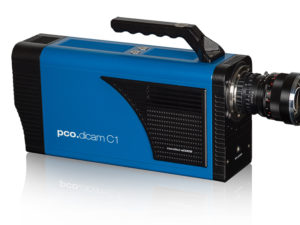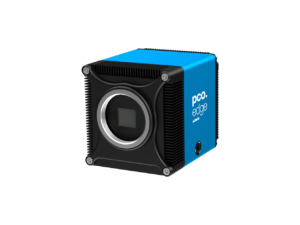Description
The pco.edge 4.2 LT is is equipped with an innovative scientific CMOS sensor providing crisp images and precise measurements. The pco.edge 4.2 LT camera system is designed for users who require highest quantum efficiency, best 16 bit dynamic range, high frame rates and long exposure times. In addition, the air cooled camera has an extremely low readout noise of 0.8 e- med. The camera has a USB 3.0 interface and is the lite version of the pco.edge 4.2. Use the pco.edge 4.2 LT sCMOS camera system with the latest software from PCO.
Key features:
- thermal stabilization at +10 °C
- extreme low readout noise of 0.8 e- med
- high resolution of 2048 x 2048 pixel
- dynamic range of 36 000 : 1
- quantum efficiency above 70%
- rolling shutter: 500 µs to 10 s
- global reset: 30 µs to 2 s
- maximum frame rate 40 fps
- USB 3.0 interface
- dimensions: 102 x 79 x 70 mm
Technical Specifications:
| Unit | Setpoint | pco.edge 4.2 |
| Resolution (hor x vert) | pixel | | 2048 x 2048 |
| Pixel size (hor x vert) | µm | | 6.5 x 6.5 |
| Peak Quantum Efficiency | % | @ 590 nm typ. | >70 |
| Dynamic Range A/D | bit | | 16 |
| Readout Noise | e- med | USB | 0.8 |
| Frame Rate | fps | @ full frame | 40 |
| Exposure Time Range | | @ Rolling Shutter (USB)
@ Global Reset (USB) | 100 µs - 10 s
30 µs - 2 s |
| Region of Interest (ROI) | | | selectable |
| Optical Input | | | Nikon F-mount,
C-mount |
| Data Interface | | | USB 3.0 |
Quantum Efficiency Curve:

View / Download the datasheet here.
Applications Areas:
- Spinning Disk Confocal Microscopy
- live cell microscopy
- GSDIM
- PALM
- STORM
- SPIM
- SIM
- single molecule detection
- lightsheet microscopy
- FRET
- FRAP
- adaptive optics
- high content screening
- ophthalmology
- flow cytometry
Application Examples:
Modular Wafer Inspection with pco.edge 5.5
 Silicon carbide (SiC) is a wide bandgap semiconductor, which is especially used for high-power, high-temperature and high-frequency devices due to its high energy efficiency. Despite great improvements in the material quality of SiC substrates and epitaxial wafers within the last years, critical defects like stacking faults (SFs) and basal plane dislocations (BPDs) can still lead to bipolar degradation and finally to complete failure of the device. Read more about this here.
Silicon carbide (SiC) is a wide bandgap semiconductor, which is especially used for high-power, high-temperature and high-frequency devices due to its high energy efficiency. Despite great improvements in the material quality of SiC substrates and epitaxial wafers within the last years, critical defects like stacking faults (SFs) and basal plane dislocations (BPDs) can still lead to bipolar degradation and finally to complete failure of the device. Read more about this here.
Fluorensce Microscopy DNA Micro Arrays with pco.edge series
 Microarrays are versatile tools for high throughput screening. Nevertheless they are severely limited. Either the molecules are synthesized in-situ directly on the surface or in-vitro or in-vivo produced externally and then transferred onto the surface. In-situ synthesis shows low yield in terms of purity and restricts therefore the biomolecule probe length to ~50 bp for light-synthesized DNA (Affymetrics) or ~200 bp print-synthesis (Agilent), but allows up to millions of spots per array. Ex-array synthesis on the other hand provides high-purity molecules, but the (bio)synthesis and purification of these molecules is tedious, time consuming and expansive. Also the printing process takes time. Even if one spot can be made per second 100,000 spots will take more than a day. Therefore the idea arose why to copy microarrays. Why not make DNA, RNA and protein microarrays as high quality copies of a high quality original? It worked fine for text books and images. So why not apply it for DNA? Why not build a biomolecule copying machine? A biomolecule xeroxer? Read more about this here.
Microarrays are versatile tools for high throughput screening. Nevertheless they are severely limited. Either the molecules are synthesized in-situ directly on the surface or in-vitro or in-vivo produced externally and then transferred onto the surface. In-situ synthesis shows low yield in terms of purity and restricts therefore the biomolecule probe length to ~50 bp for light-synthesized DNA (Affymetrics) or ~200 bp print-synthesis (Agilent), but allows up to millions of spots per array. Ex-array synthesis on the other hand provides high-purity molecules, but the (bio)synthesis and purification of these molecules is tedious, time consuming and expansive. Also the printing process takes time. Even if one spot can be made per second 100,000 spots will take more than a day. Therefore the idea arose why to copy microarrays. Why not make DNA, RNA and protein microarrays as high quality copies of a high quality original? It worked fine for text books and images. So why not apply it for DNA? Why not build a biomolecule copying machine? A biomolecule xeroxer? Read more about this here.
Time Lapse 3D measurements with pco.edge series
 Light sheet fluorescence microscopy has previously been demonstrated on a commercially available inverted fluorescence microscope frame using the method of oblique plane microscopy (OPM). In this paper, OPM is adapted to allow time-lapse 3-D imaging of 3-D biological cultures in commercially available glass-bottomed 96-well plates using a stage-scanning OPM approach (ssOPM). Read more about this here.
Light sheet fluorescence microscopy has previously been demonstrated on a commercially available inverted fluorescence microscope frame using the method of oblique plane microscopy (OPM). In this paper, OPM is adapted to allow time-lapse 3-D imaging of 3-D biological cultures in commercially available glass-bottomed 96-well plates using a stage-scanning OPM approach (ssOPM). Read more about this here.
High Speed Florescence Microscopy with pco.edge series / pco.1600 / pco.sensicam
 The application shows that the mode and dynamics of trypanosome locomotion are a trait of life within a crowded environment. Using high-speed fluorescence microscopy and ordered micro-pillar arrays we show that the parasites mode of motility is adapted to the density of cells in blood. Read more about this here.
The application shows that the mode and dynamics of trypanosome locomotion are a trait of life within a crowded environment. Using high-speed fluorescence microscopy and ordered micro-pillar arrays we show that the parasites mode of motility is adapted to the density of cells in blood. Read more about this here.
3D Flow Field Measurements with pco.edge 5.5/pco.dimax series
 Large-volume volumetric flow experiments and their results: The first of these, investigating a thermal plume at low velocities (up to 0.35 m/s) demonstrates the abilities and requirements to reach volume sizes up to and probably beyond one cubic mete Read more about this here.
Large-volume volumetric flow experiments and their results: The first of these, investigating a thermal plume at low velocities (up to 0.35 m/s) demonstrates the abilities and requirements to reach volume sizes up to and probably beyond one cubic mete Read more about this here.




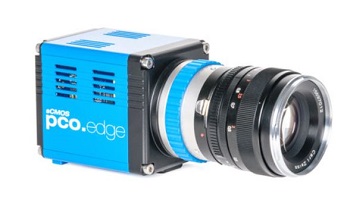
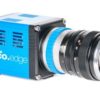
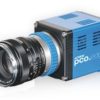
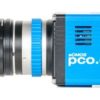
 Silicon carbide (SiC) is a wide bandgap semiconductor, which is especially used for high-power, high-temperature and high-frequency devices due to its high energy efficiency. Despite great improvements in the material quality of SiC substrates and epitaxial wafers within the last years, critical defects like stacking faults (SFs) and basal plane dislocations (BPDs) can still lead to bipolar degradation and finally to complete failure of the device.
Silicon carbide (SiC) is a wide bandgap semiconductor, which is especially used for high-power, high-temperature and high-frequency devices due to its high energy efficiency. Despite great improvements in the material quality of SiC substrates and epitaxial wafers within the last years, critical defects like stacking faults (SFs) and basal plane dislocations (BPDs) can still lead to bipolar degradation and finally to complete failure of the device.  Microarrays are versatile tools for high throughput screening. Nevertheless they are severely limited. Either the molecules are synthesized in-situ directly on the surface or in-vitro or in-vivo produced externally and then transferred onto the surface. In-situ synthesis shows low yield in terms of purity and restricts therefore the biomolecule probe length to ~50 bp for light-synthesized DNA (Affymetrics) or ~200 bp print-synthesis (Agilent), but allows up to millions of spots per array. Ex-array synthesis on the other hand provides high-purity molecules, but the (bio)synthesis and purification of these molecules is tedious, time consuming and expansive. Also the printing process takes time. Even if one spot can be made per second 100,000 spots will take more than a day. Therefore the idea arose why to copy microarrays. Why not make DNA, RNA and protein microarrays as high quality copies of a high quality original? It worked fine for text books and images. So why not apply it for DNA? Why not build a biomolecule copying machine? A biomolecule xeroxer?
Microarrays are versatile tools for high throughput screening. Nevertheless they are severely limited. Either the molecules are synthesized in-situ directly on the surface or in-vitro or in-vivo produced externally and then transferred onto the surface. In-situ synthesis shows low yield in terms of purity and restricts therefore the biomolecule probe length to ~50 bp for light-synthesized DNA (Affymetrics) or ~200 bp print-synthesis (Agilent), but allows up to millions of spots per array. Ex-array synthesis on the other hand provides high-purity molecules, but the (bio)synthesis and purification of these molecules is tedious, time consuming and expansive. Also the printing process takes time. Even if one spot can be made per second 100,000 spots will take more than a day. Therefore the idea arose why to copy microarrays. Why not make DNA, RNA and protein microarrays as high quality copies of a high quality original? It worked fine for text books and images. So why not apply it for DNA? Why not build a biomolecule copying machine? A biomolecule xeroxer?  Light sheet fluorescence microscopy has previously been demonstrated on a commercially available inverted fluorescence microscope frame using the method of oblique plane microscopy (OPM). In this paper, OPM is adapted to allow time-lapse 3-D imaging of 3-D biological cultures in commercially available glass-bottomed 96-well plates using a stage-scanning OPM approach (ssOPM).
Light sheet fluorescence microscopy has previously been demonstrated on a commercially available inverted fluorescence microscope frame using the method of oblique plane microscopy (OPM). In this paper, OPM is adapted to allow time-lapse 3-D imaging of 3-D biological cultures in commercially available glass-bottomed 96-well plates using a stage-scanning OPM approach (ssOPM).  The application shows that the mode and dynamics of trypanosome locomotion are a trait of life within a crowded environment. Using high-speed fluorescence microscopy and ordered micro-pillar arrays we show that the parasites mode of motility is adapted to the density of cells in blood.
The application shows that the mode and dynamics of trypanosome locomotion are a trait of life within a crowded environment. Using high-speed fluorescence microscopy and ordered micro-pillar arrays we show that the parasites mode of motility is adapted to the density of cells in blood.  Large-volume volumetric flow experiments and their results: The first of these, investigating a thermal plume at low velocities (up to 0.35 m/s) demonstrates the abilities and requirements to reach volume sizes up to and probably beyond one cubic mete
Large-volume volumetric flow experiments and their results: The first of these, investigating a thermal plume at low velocities (up to 0.35 m/s) demonstrates the abilities and requirements to reach volume sizes up to and probably beyond one cubic mete 